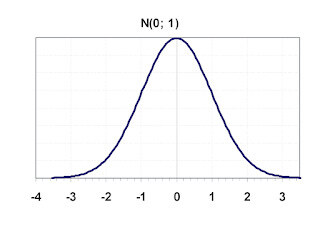[Re-post] The Normal Distribution and the Act Like a Man Box
I've been thinking again about "manhood" and what it means—or what we think it means—to be a man. I was thinking about it a year ago when I first wrote this piece, and I’m thinking about it again today, in the midst of this era of tech bros and podcast bros and overly-pumped-up, heavily tattooed bros yelling at everyone else about what Real Men do and say. The Bro-ocracy is bringing me down. I need a little more The-Dude-Abides in my world.
I am not a psychologist or a sociologist or any other kind of -ologist qualified to say anything with authority. Let me put that our there right here at the top. I’m just a guy, thinking out loud. I'm a guy who has been a man for his whole life and a father of two men for nearly 23 years. But that's all I am, so...caveat lector.
What I keep thinking about is: what is normal? Statistically (I’m not a statistician), normal is not a single thing; normal is a distribution around a mean. We’ve all seen the “bell curve.” To be formal about it, according to this statistics website:
The normal distribution is a continuous probability distribution that is symmetrical around its mean, most of the observations cluster around the central peak, and the probabilities for values further away from the mean taper off equally in both directions.

A “continuous probability distribution” feels very quantum-physics-y to me in its suggestion that reality is less concrete and fixed that we perceive it to be—more wave than point, more probability than certainty. (I’m not a physicist—these are all just the ramblings of a promiscuous and fairly dilettante-ish reader.)
Todd Rose tells some amusing anecdotes, in The End of Average, about times when we have sought an actual individual to represent the “average” of a set of qualities representing manhood or womanhood. In both cases, the search came up empty. There was no single person who represented all the mean scores of all the manly or womanly qualities; the pure middle was an empty set. We are ‘jagged,” Rose says. One fact doesn’t always carry with it all the other facts that may adhere to it in the mean.
Qualities exist across a continuum, and they bunch and gather around the mean. Imagine a normal distribution of traits and behaviors that we have historically thought of us “masculine,” with the more feminine at the left-hand tail and the hyper-macho at the right hand-tail. (I’m making this up.) Most men might bunch and gather around the mean as aggregates of behavior, but if you isolated particular behaviors, or attitudes, or affects, our individual scores might be all over the place. That’s what makes us jagged individuals.
That’s what makes us individuals, but we socialize ourselves and each other pretty hard, as men, to fit ourselves snugly inside what Rosalind Wiseman calls “the Act Like a Man” box. There is one acceptable way to be a boy or a man—deviate from it at your peril.
We’ve been raised with some pretty hardcore, binary thoughts about gender and sexuality. “Normal” men are one thing, feel one thing, behave one way, are attracted in one way to one opposite sex. Anything that deviates from that “normal” is, by our definition, deviant. But the reality is that “normal” is a cluster of things hovering around a mean, not a singularity where all things meet. If there is such a thing as mean masculinity, it exists only because most cases of Actual Men hover around that point, at locations somewhere to one side or another of that mid-point it in equal measure. In other words, not all men are exactly X in all things (or in any things); some men are a little X+ in certain traits or on average (meaning to the left of X, not better than X) and some are a little X- (meaning to the right of X, not lesser than X); some are a LOT X+ and X-.
But what have we men done? We have looked at that distribution and we have invalidated almost everyone to the left as being dangerously “faggy” or “gay.” Maybe only the tail; maybe almost all the way up to just short of the mean. Depends on the generation. But even in our relatively enlightened times, too many of us live in terror of anything to the left of the mean, and hope that we, personally, are never tagged as being in that group. But the extreme right? Oh, the extreme right is considered totally safe and viable: the hyper-macho, the toxic, the brutal—those are all considered permissible ways of being a man. So, we don’t just accept the cluster around the mean—we say “real men” exist at the mean and all the way out to the furthest extreme of only the right-hand tail, while anything even slightly to the left of the mean is dangerous and to be shunned. Tell me that’s not fear-based behavior.
Remember—the mean, the average, the “normal” would not exist unless there were equal numbers of cases on BOTH sides of it. That’s how the distribution works. Which means there are a hell of a lot of us to the left of the mean (in aggregate and also in a variety of individual traits). In fact, there have to be as many of us on the left as there are on the right! But we’ve decided to make invisible and untouchable any expression of masculinity that exists to the left-of-X. Those traits cannnot exist and must not exist in the Act Like a Man box.
Which is ludicrous, right? Because if the values to the left of the mean disappeared, the mean would shift hard towards the right. By definition. But we like to pretend that nothing to the left of the mean is part of who we are, and we reinforce that idea constantly.
Would gay men, measured alone, fall into the same rough distribution of traits and behaviors, or would their mean skew a little to the left? I don’t know. Would straight men pulled out into a separate group skew a little to the right? I don’t know.
What I do know—or sense, because, again, I have no expertise in any of this—is that all of this—all of it—should be considered a normal and ordinary range of human expression.
Why does that matter? It matters because people in the majority (the clump around the mean) like to pretend that minorities do not exist—or, at the very least, that their existence as minorities makes them less-than-worthy or less-than-real or less-than important. But remember: in a distribution, the extremes help to define the mean. And remember: so very, very much of life on earth falls into these kinds of distributions. For any set of values clumped around a mean, there are always tails at either end. They are not weirdos or deviants or wrong. They simply represent the tails—they are people with certain traits expressed less often than others within a particular population. But they are expressed. They are part of the data set. They are part of us. They help define us. They belong.
Again: go searching for the individual person who is a perfect representation of the average of all traits—Mister Perfectly Average Man, and you’ll come up with an empty set. There is no perfectly-averagely-masculine man. If masculinity were made up of 100 separate traits, none of us would register at-the-mean 100 times. We’d be a little to the left here, a little to the right there, a little further out in some areas, a little closer in for others. As individuals, we are all over the map—and yet, so many of us are terrified of allowing ourselves to vary. At. All.
There are as many ways to be a man as there are men. There is no box. There is no fucking box. We need to just stop. We need to let some air in and let each other breathe.
Scenes from a Broken Hand
- Andrew Ordover's profile
- 44 followers



